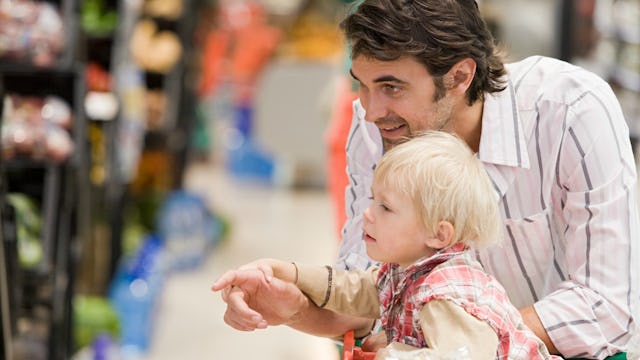The Walmart Produce Section (Unexpectedly) Brought My Son And Me Together

“Whose kid is this?” A loud, booming voice could be heard over my left shoulder. I held the cooler door open with my right hand as I turned my head in the direction toward the man’s voice.
It was my kid, Payton.
It took him no more than a few seconds (literally) to wander about 30 feet away from me. He was standing there, startled and looking into a refrigerated, open-shelved display unit used for fruit.
The man, about 5 feet away from Payton, was very large, easily 4 or 5 inches taller than my 6-foot frame, and probably twice my weight. I dropped the shopping basket as the cooler door slammed shut and ran over to my son.
“People want to eat these. He shouldn’t be doing that!” He was just as loud as the first time. Almost as if he wanted to make an example out of my son.
“Sir, I can explain. You see, my…”
Before I could finish, he continued, “It don’t matter about your son. You need to curb your kid!”
It don’t matter? Of course it does! Doesn’t he understand?
My inner voice was formulating a wonderfully articulate response about the tendencies autistic children have in a new environment. But I knew it was useless.
The Walmart produce section isn’t the place to hold an intellectual conversation about the skills necessary to raise a child on the spectrum. And even if it was, this man surely wasn’t going to have any of it.
“Yes, sir. I’m sorry. I will keep a better eye on him next time,” I responded as I stepped between him and Payton.
“Well, you better. We all are shopping here and don’t need our fruits all messed up.”
“I understand. Thank you.” And with that I turned around, realizing I didn’t even know why the man was upset in the first place.
On the open shelves, and in the cooler below, were dozens of watermelon slices neatly packaged on white Styrofoam squares and wrapped with cellophane. At first, I couldn’t find any reason why the burly man made such a scene. Perhaps Payton was simply in his way. But the display was huge with plenty of room for anyone to easily select a nice piece of watermelon.
And then I saw it. On the lowest shelf just above the cooler there was a piece of watermelon with what appeared to be holes in it. There were about five or six holes pushed about an inch deep into the flesh of the watermelon, just the size of a 5-year-old’s finger.
I looked at the next one which had about four holes pressed into the cellophane and into the fruit Below, another one with about eight holes, another with six holes, and another. In total, there were about a whole watermelon’s worth of slices which Payton had effectively dented into cratered pieces of pink fruit.
The picture formed in my head. In the few seconds I was determining if I wanted sausage or pepperoni on our frozen pizza, my son was systematically ruining each piece of watermelon with his tiny fingers. Payton was a quick worker, and I could see that it may not have taken much longer for the remaining “good” pieces to feel his wrath, and the burly man sought to stop it immediately.
I had read early on and then seen firsthand how Payton will explore his environment through tactile signals. He loved to touch, hold, and feel everything. And there he was, sticking his finger in fruit.
I looked down at him. He briefly looked back, a bit curious but unconcerned, and swiftly proceeded with his mission of sticking each piece of watermelon with his index finger.
I didn’t stop him, but instead just watched for a moment. Squish, squish, squish. He kept going one hole at time. After five or six holes, he moved on to the next piece.
I don’t know why I did it, but I stuck my finger into a piece which was on a higher shelf than Payton’s, almost chest-high. Squish.
I could feel the watermelon easily give way under the pressure of my finger. Even more, I could feel the actual structure of the watermelon break down the farther I pushed in. It was a curious sensation, one that I did not expect.
Payton stopped.
He was looking up at my piece of watermelon. Then he looked at me, in my eyes, for longest time I could ever remember.
I looked back at my piece of watermelon and gave it another squish from my finger. My head turned back to Payton who was watching intently. Then he turned and stuck his tiny finger into a fresh piece of watermelon. He looked back at me with a smile — it was now my turn.
The back-and-forth continued. His turn, my turn. A few minutes had passed before a store employee approached.
“I’ll pay for any damaged watermelons,” I said before she could speak.
I can only imagine what other people were thinking as I could feel eyes setting upon us and nods of disapproval from the periphery, but I didn’t care. Payton and I had a job to do, or maybe it was a game.
Either way, for the first time since Payton was diagnosed with Fragile X syndrome three years ago, I felt we were on the same page, completely and uniquely connected through this new, fun activity of ours.
Finally, it happened. We became a bona fide father and son team that day! A team I wasn’t sure would ever form until that day we found watermelons at Walmart.
This article was originally published on